Tarot Wyzdom with Love: Tarot Spreads and Jams #7/10
Tarot spreads are easy to use without getting in a jam.
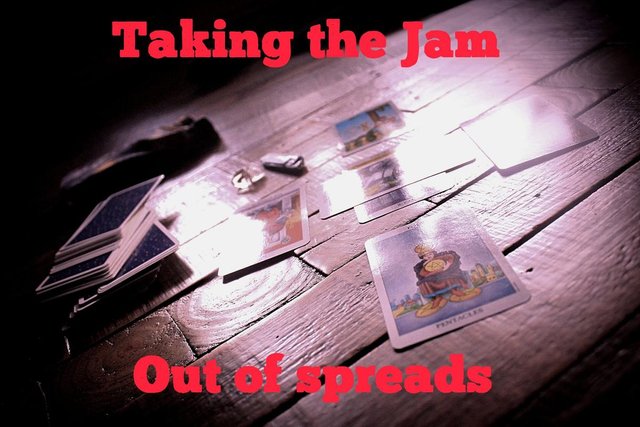
The following are the methods that have been developed over many years.
These methods are clearly outlined below to get you easily using endless tarot spreads with joy and ease. For many, many years I have been doing spreads in this manner. It is simple, fluid and lends itself to learning many other esoteric teachings simultaneously.Before we dive in, it’s important to address that you have a good tarot deck for genuine study.
If you don’t understand what a good tarot deck is then, go ahead and click over to our second post in this series. These articles are specially designed to quickly get you using your tarot cards like a pro.
9 Important Things to Know for Choosing and Cleaning Your First Tarot Deck
If you missed the first post in this series,
7 Steps in 30 Minutes or Less to Learn the Tarot Cards,
here is the link to get you caught up.The third article is
Tarot Wyzdom with Love: How to Dissect the Tarot Cards.
Great basic stuff!The fourth article in this series is
4 Easy Steps to Conquering the Court Cards.
The fifth and last, up to this point is
Tarot Wyzdom with Love: Making Sense of The Major Arcana.
Test yourself to see how well you are learning the material or use this test to guide you through your study of the cards. This exam covers the material presented in Lessons 1 - 5.
Tarot Wyzdom with Love: Lessons 1 - 5 Midterm Quiz, Get ready to be Tarot Tested.
The Pip cards are of the three main groups always found in the tarot. These tarot groups were first presented in an earlier blog,
Tarot Wyzdom with Love: How to Dissect the Tarot Cards.
Visit this blog for more information about the tarot groups.For the 6th blog and a more in-depth explanation of the Pip cards, check out
Tarot Wyzdom with Love: The Pippin' Cards #6/10,
also, the first in part 2 of these 10 lessons.These articles all build on each other or can be used as a stand-alone to address specific topics or as a complete study course for learning the often daunting tarot basics.
This is the seventh lesson in this series of 10 articles to get you easily and quickly using your tarot cards like a pro.
So, let’s get to it!!
--------------------------------------@@@--------------------------------------
The biggest confusion most new readers of the tarot encounter when using tarot spreads is how to apply the meaning of the card to the position of the spread the particular card falls on.
So, if you have, say, the Knight of Swords and it falls on the position of the Past, there may be a confusion about how this guy applies to the past.
Then, the other challenge new readers often have is breaking out of the Celtic Cross box. This is a good spread for beginning with for many people. Some people will love this spread and see no reason to try others, and that’s fine. For others, like us, find it very limiting and outdated.
This lesson covers:
- How to apply the card and question to the position
- How to create your own spreads to fit the need.
- What about the significator?
Apply the card and question to the position.
To be very honest, confidence in reading a tarot card with its position and question in mind just takes practice. When using a standard, traditional spread/s, you must not take the card too literal, such as the Knight of Swords. It is not necessarily a man or a person carrying a weapon. The Death card does not mean someone will die.
To begin, let's do a pretend reading to create an example.
The Knight of Swords could easily be a very focused woman. Swords are about communication, not about weapons. Knights are about movement. So, if this card lands on the Past and the client is asking a question about getting a raise at their job. This card might indicate that, in the past, the client communicated she requested a raise while being very direct.
Let’s pretend the client pulls the Death card for Present. The Death card often stumps new users of the tarot. In 20 years of tarot reading, we have only seen this card actually come up once to mean actual physical death. In this case, asking for a raise, the client is getting a negative response from her supervisor. The card is likely telling the client to let it go. This is not a good time.
For the Future card, imagine the client has the 6 of Cups. This card is about giving and sharing from the heart. Wait a few weeks and the company’s situation will be brighter and they will happily give you the raise you deserve.
Then, after reading all the cards go back and put it together for a little story to tell your client. “When you asked your supervisor for a raise you went in too fast without thinking about the situation of the company financially at the moment. This caused you to get a very negative response but wait a few weeks when the company is in a better position then you will more than likely receive your request.”
The variations of cards to positions in a spread are endless. You just have to practice.
Another tip for getting it right is, “Trust YourSelf!!” When you second guess yourself is when you will screw it up. Go with what first pops into your head. Really!
Creating your own designer spreads: (This is where using tarot spreads can be a lot of fun)
Here are a few favorite ways we like to create spreads.
- Using a symbol that already exists for the Spread form.
- Create a quick intuitive spread
- The basic A-Card-A-Question spread.
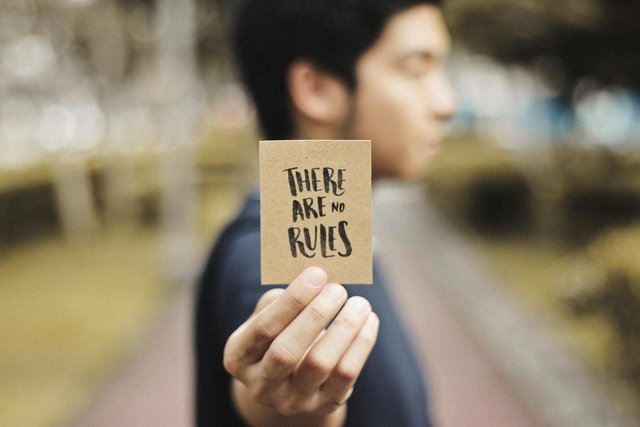
Symbols that already exist.
Examples of symbols that are great for tarot spreads are:
- The pentacle and cross
- A heart
- A clock
- Kaballah Tree of Life
- Yin/yang
- Molecular structures (Ex: H2O)
- The Chakras and the body
- Anything you associate with meaning and to be relevant to answering a question or giving wyzdom in general.
There is literally a symbol in existence for everything and anything. If it is not already written then it is written in your heart and you just need to create it.
- A favorite spread to use is one I created called the Four Directions Spread. It’s a great all-purpose spread based on the Pentacle. This symbol represents the four directions and ether. Holding to their symbolic positions and significance, these define this easy 5 card reading. The positions are labeled north, south, east and west. If you have done any study of the pentacle then this will be easy as you already know the correspondences to the 4 directions and ether. Peace of cake!
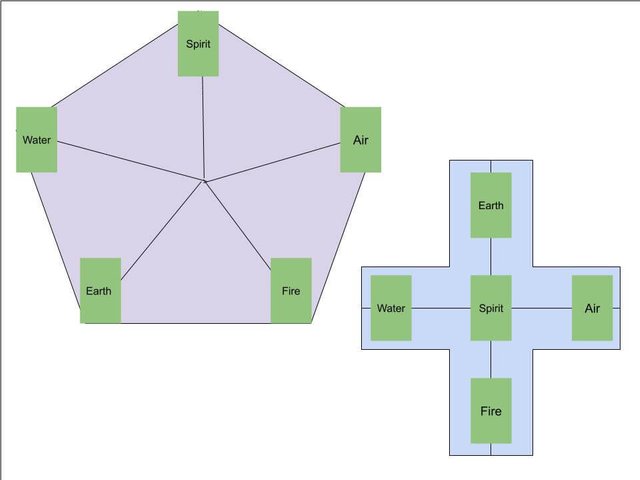
- The heart might be considered for a love or relationship reading for 2. Lay the cards in the shape of a heart. Single cards in the center of the heart represent unity and solutions while each side of the heart represents each partner. Label the positions according to the specific needs of the couple. Very powerful!
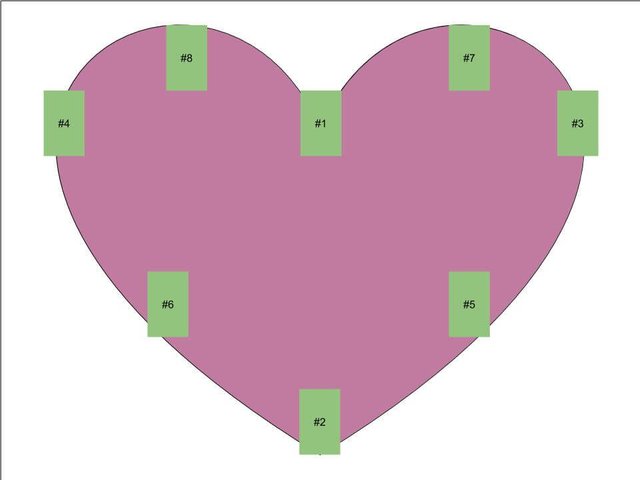
- A clock has 12 hours, the same as a year and the astrological signs. Layout the cards in a circle, beginning with one o’clock, placing a card at each hour for a total of 12 cards then maybe add a 13th to the center. Think of each hour as a passing situation, comparable to the hero’s journey. In the beginning, there is optimism, at 1 o’clock, then by 6 o’clock we are stuck, hit the bottom, and finally, there is a journey back to the top, to 12 o’clock. Additionally, the hours can represent months or the zodiac for a great birthday or New Year’s reading.
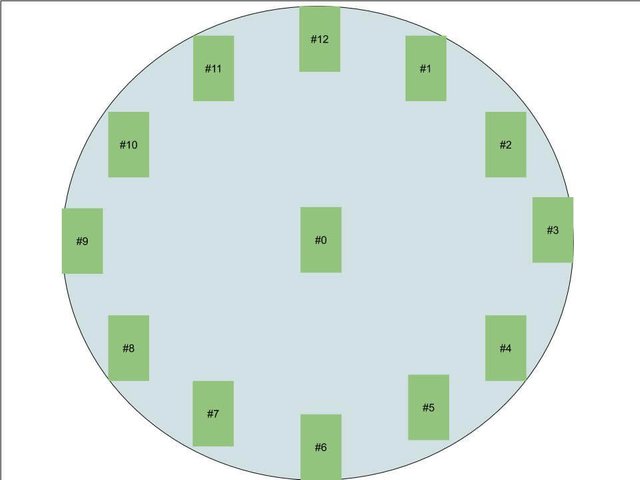
- Are you ready to learn this complex system or maybe you already have a background in the Tree of Life system? Lay a card on each point and use the correspondences of these ancient points for the meaning of the position. Clear some space. This is a big one.
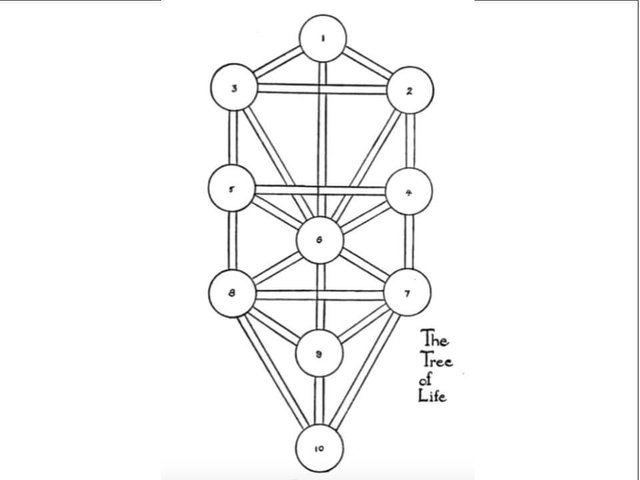
- Great for relationships, getting clear on balance with your life or even gender issues might be perfect for the Yin Yang symbol.
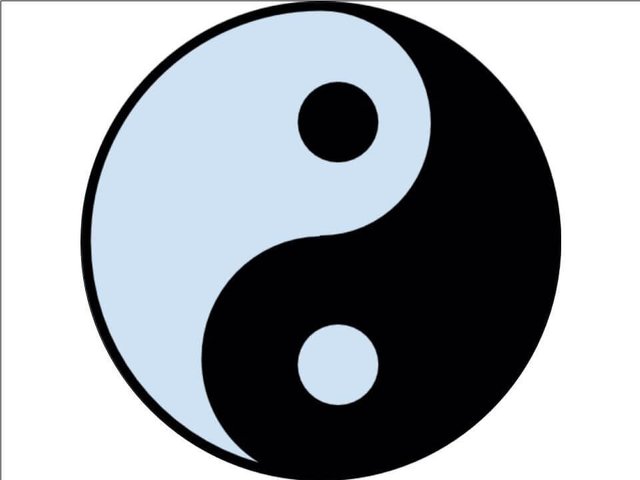
- Try turning in a term research paper to your biology instructor explaining how molecular chains are the foundation of great tarot spreads. Whether she is impressed or not, you will as a result of writing the paper have a deeper understanding of each part of the chain as each part is a position for your card, as well as, the definition of that position. Give it a try. Mind exploding!

Notice, too, that this one also has the same shape as the female reproductive organs. How might that perspective change the meaning of the positions?
- Each chakra has many layers of meanings and correspondences. If you are familiar with the chakras then this might be a great “go-to” spread for you, covering all areas of your querent’s experience.
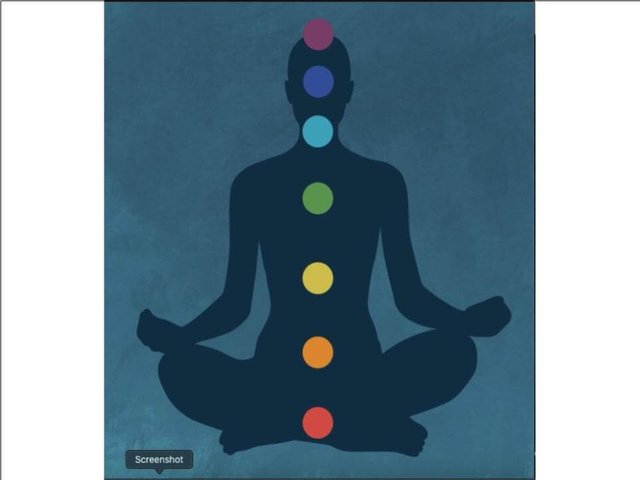
- After reading #1 - 7 you should now be clear with how you can take anything that has meaning to you and use it as the foundation of a tarot reading. There’s no limit. Let us know what you have tried.

The second method to create spreads is through the Intuitive Method.
Often when a querent begins explaining to me their situation, what they are searching for, they won’t really have a specific question for the cards. At this moment I might feel compelled to use this method to help the client get clear on what they are seeking from the cards. More or less, this is how I assist them to be clear on what they are seeking and what are the specific questions they are wanting to be answered.
Hold the cards in your hands, covering the cards.
Take a breath.
Ask the spirit of cards and your guides, or whatever you want to assist you in sharing guidance to the highest good all.
I like to imagine a golden light of energy coming from the heavens, through the querent seated in front of me, through my cards, then my body and out my mouth. I conclude by giving thanks that it is done. This only takes a moment, inside my head and no one knows that I am doing this except for the vibration of the space has noticeably shifted.
While shuffling the cards in your hands ask the querent to explain how this makes them feel and how are they feeling right now. Emotion puts out energy which supports a good reading. The sound of and the feel of the cards shuffling in your hands will, over time, create a subconscious connection that you are going to a place to access your subconscious, the place where wyzdom is stored.
At this time ask in your head, “how shall I lay out the cards?” Do not question the answer! Don’t second guess it. Just do it! I get all kinds of interesting stuff. I get pyramids, letter H shapes, T shapes, interlocking circles, etc.
Now is the perfect time to clarify a great question since you have heard the querent's situation and feelings. Everyone wants love and happiness. Some want a deeper spiritual connection. This topic will be covered in future lessons with much more detail.Once the querent has chosen the cards, place them in the positions you saw in your mind’s eye. While you are laying down the cards you will get a clear vision of what the positions are if you have not already.
Let’s do an example together. Pretend that a friend, Jane Doe, who is on your mutual admiration list, calls you after not talking to her much over the last year or so. You’re excited to hear from her and catch up. Jane immediately begins spilling out about how… umm, let’s see. Something typical people ask about…”Love, I think John is cheating on me.”
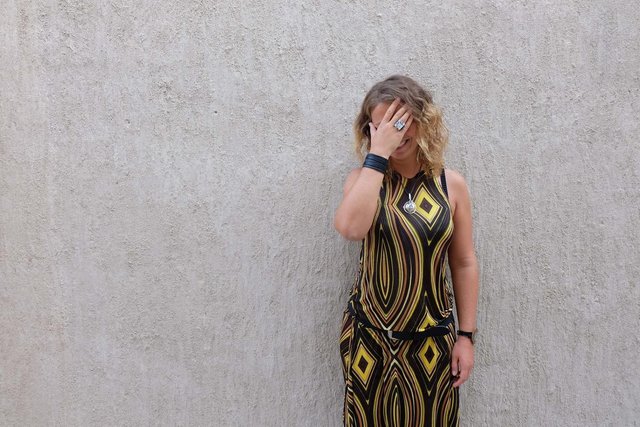
“Hey, Gurl, you wanna look at the cards and see if we can get you some insight?”
“Oh! my, God! Yes, please! Thank you!” Jane is already emotionally involved in the reading.
“Let’s switch over to a video call and I can get you going.”
As I grab my cards and take a comfortable seat in front of the strategically placed phone screen I am already beginning to take my deep breath, clear my head, envision a golden cleansing light and asking the questions to support me in helping Jane.
When I am comfortable with the cards in my hands I get more focused and tuned in. A client will not mind waiting and will respect the process. Jane keeps running her yapper and chatting on and on about her crappy husband, John. Now I will guide Jane to join me in getting centered.
“Jane, explain how all this is feeling to you right now.” While I shuffle I listen mostly to my thoughts and some to Jane going on and on about how this time she will leave him for sure, again. She is fed up and tired. Her words are not as important as the emotional vibration she is creating.
While you are shuffling you will get a sense or a picture in your head of how to layout these cards. Don't force it. Just shuffle, relax, breath. For Jane, today we get an alarm clock shape. It is time for Jane to hear the alarm and wake up.
“Jane, I will give you this reading but just know, what I am getting is that it is time to learn what you need to do to wake up, stop worrying about John and move out of being a victim. I will tell you if he is cheating on you but I will also show you how you can take responsibility for your life and be free of attracting men whom you don’t trust. Are you ready?”
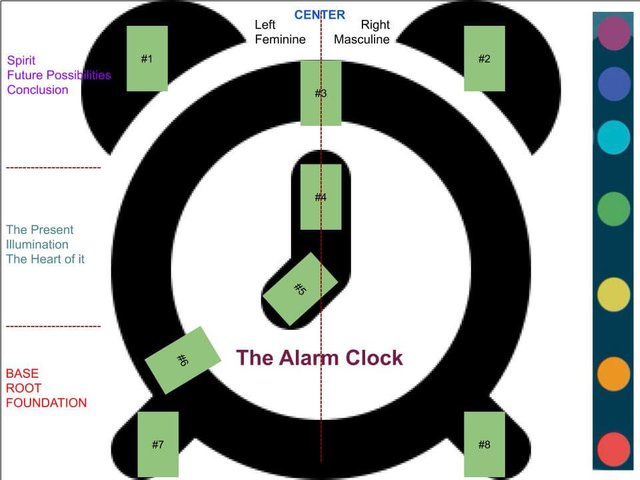
So, now, you see, the symbol which is given by spirit also gives way to bringing valuable information to the client as well as giving greater scope to the reading itself. Allow your mind’s eye to instruct you on how Jane’s alarm clock looks in the form of a tarot reading.
The cards on the left are feminine and the right is masculine. The center cards represent balance. Being even more specific, the right is John and the left is Jane. Any cards falling in the center will be guidance, wyzdom, a fresh perspective or best options.
Cards toward the bottom of a spread can be seen as the root, unseen, past, the beginning or the foundation. As you move up the spread consider the chakras, present, becoming illuminated, what’s in the thoughts and hearts of…, what is being seen or obvious. Moving toward the top of a spread consider the higher chakras, possible outcomes, best to be expected, what needs to change or needs to be seen. Consider any system that feels good to you.
This system is highly driven by intuition. For some, it is more advanced but others will take to it like a fish to water. Practice with friends to gain your confidence.
For Jane’s alarm clock, considering what I just described about some of the ways in which to define the areas of a reading, the following is how one might define the card positions for Jane.
This is the bell, the left side, and the top, possibly a crown chakra association. Jane will see here what she needs to do to nurture herself to support her in maintaining her highest good.
This is the bell, the right side, and the top, possibly a crown chakra association. Jane will see here what action she must take to support her in maintaining her highest good.
This 12 o’clock. This card represents what Jane needs to wake up to and see.
The big hand represents the minutes. What does Jane need to get moving on right away? What is she squandering time on?
This is the hour hand. Just for fun, let’s say that the number of the card is the hour. With cards #13 - 21 just reduce the digits to an applicable number by adding them together. Move the hour hand card around to its appropriate space. For a court card, you could decide to either draw an additional card for the hour until you get a number or the younger 2 characters are 11 and the more mature 2 characters are 12.
- This position could have many possibilities. It represents the hour, the hour to wake up, the hour to get shit done, when to start making the next move or even when you will start seeing a change and an opening in which to make a change or move.
Based on the hour, depends on where this card might land. This might be a great place to build on a numerology or astrology message. For example: If the hour is four and the #6 card turns up as a 4, then you have something very interesting indeed. Now you have a deep number four numerology reading. Be creative in all the ways you could play with this.
The clock leg on the left supports the clock and gives it balance from being too passive. While Jane goes through her awakening she will need support and ways to manage all the motions she will surely encounter. This card might address how she shall achieve that.
The clock leg on the right supports the clock and gives it balance from acting in a way one might later regret. While Jane goes through her awakening she will need support and ways to decide the best action to take for staying centered to not act on anger. This card might address how she shall achieve that.

The third way we like to create spreads is
the basic “A-Card-A-Question” method.
Imagine Jane is rattling on endlessly with many questions, saying things like:
- “I don’t know what to believe anymore”.
- “I don’t know who to believe”
- “Is John in love with her?”
- “Should I leave him?”
- “What should I do?”
These are just examples of some questions you might hear.
Lay down a card for each question she has. That card is the answer to that question. If the card does not make sense or is unclear, add another. Keep adding cards to each question until it all makes sense or you feel you have a solid answer.
3.What about the significator?
From the very beginning of my early days of reading tarot cards, when I was first introduced to the idea of the significator, Immediately I believed it unnecessary. As a result, I have never used it.
A significator is a card which is removed from the deck, usually before the reading and shuffling begins. This card represents the client or querent. It is chosen based on things such as their age, birthdate, sex from the court cards.
Many top readers today no longer take a significator, although a few still do.
The truth is, neither method is right or wrong. Just spread them out and don't let your mind get you in a jam.
===========================@@@==========================
ACTIVITIES:
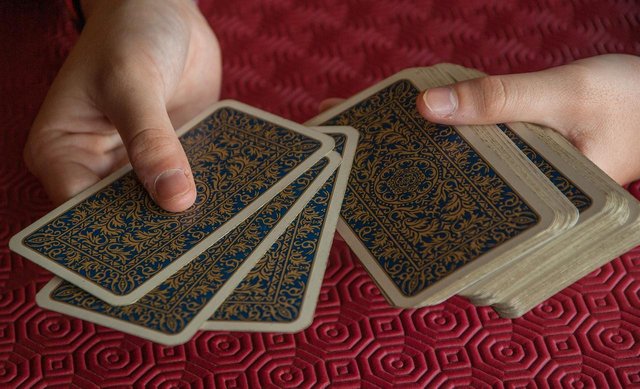
3 Card Spread Challenge
Practice applying the card and the question to the position.
You will need: A pen, your tarot journal, any tarot deck you want to practice using.
Write down a series of five questions to ask the tarot
Write down three different 3 card tarot spreads.
Shuffle the cards normally then layout 3 cards.
Beginning with your first tarot spread and your first question write down your interpretation of each card.
Using the exact same cards, without moving them, change the spread to the next one in your list of three. Use the same question and write your interpretation of the same three cards but are now in a different three-card spread.
Continue with the first question until you have written your interpretation for all three 3 card spreads.
Start again with the second question, going through all three of the card positions. Continue until you have completed all 5 questions using all three 3 card spreads.
This a truly great exercise to support your mind in learning to think this way. Repeat with 3 new cards. Do it with a friend then discuss the interpretations you each wrote.
Below is a chart to show an example of how you might get started. Some of the possible interpretations are filled in for you. Create your own questions, draw new tarot cards, come up with other 3-card spread ideas. Practice with your friends and share your answers.
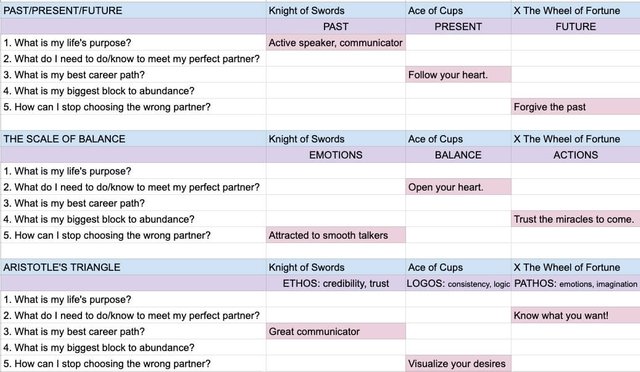
Intuitive Spread practice
You will need:
A pen, your tarot journal, any tarot deck you want to practice using.
Write down some questions you might ask the tarot. Ask others to give you some ideas.
For each question, make a list of possible objects or symbols you might use to answer those questions.
Draw the symbols and write rectangles where you might place a tarot card.
Number the cards.
Write down a position for each card placement meaning. If you get stuck try using the Alarm Clock illustration above for additional suggestions.
Reread Jane’s story in the Intuitive Spread section for information on how to proceed with this exercise.
Do this exercise with friends and discuss your answers.
A card-a-Question Practice
Try this.
Watch a movie, a sitcom, a news story, or the latest celebrity gossip.
When the story reaches its climax or when you feel like you have formulated a few questions about the story and the people in it, stop the story and begin.
Formulate a list of questions in your head or write them down.
For each question, lay down a card.
There it is. There’s your answer.
Don’t get it?
Lay down another one.
Still doesn’t make sense?
Then add another. Keep going until you feel clear.
Do this for each question you formulated.
With a friend, each of you writes a list of questions then trade your questions with one another.
Have fun with the activities.
Tell us about your experiences down below.
Now you are equipped to stay out of
sticky jams and into smooth spreads.
---------------------------@@@@@-------------------------
Clicking through these links and/or making any purchase
through them supports Love and
continuing the Epic Journey.
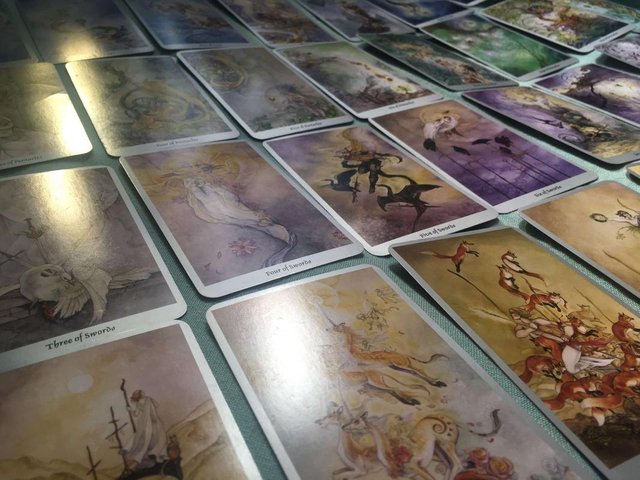
Curious about the deck above?
It is the The Shadowscapes Tarot Cards deck. Click to take a closer look. It is a very beautiful deck by one of our favorite deck creators, Barbara Moore.
Also from Barbara Moore, concerning the topic of tarot spreads we recommend Tarot Spreads: Layouts & Techniques to Empower Your Readings.
In addition, take a look at
The Ultimate Guide to Tarot Spreads: Reveal the Answer to Every Question about Work, Home, Fortune, and Love by Liz Dean
365 Tarot Spreads: Revealing the Magic in Each Day by Sasha Graham
Complete Book of Tarot Spreads Paperback – March 4, 2014 by Evelin Burger
Although there are no specific book resources for the Pip cards we recommend these great books for more activities and ways to get to know your cards.
Another fun activity book we highly recommend is The Tarot Coloring Book. Coloring in the cards is a great way to familiarize yourself with every detail of every card. Make yours with your own original colors or attempt to replicate the cards exactly the same as Rider-Waite.
When approaching the tarot cards from a scholar’s perspective it is a good idea to have some quality reference material on hand. We encourage you to grow a good library to have on hand while going through these basic lessons as well as the more vast Tarot Course study which is to follow the 10 lessons.
Recommended topics to begin stocking your library for deeper research of the tarot are: Numerology, Astrology, sacred geometry, kabbalah, and the Hebrew alphabet.
The list of books we would suggest is pretty extensive so, a few to get you started are:
- Numerology and the Divine Triangle by Faith Javane This is a relatively old book but is a classic.
- Numerology: With Tantra, Ayurveda, and Astrology by Harish Johari
- Tarot and Astrology: Enhance Your Readings With the Wisdom of the Zodiac by Corrine Kenner
- The Complete Magician's Tables by Stephen Skinner. Full of great tables and charts for defining many, many aspects of the tarot.
- Kabbalistic Tarot: Hebraic Wisdom in the Major and Minor Arcana by Dovid Krofchow This is one of our favorite resources for addressing the Tree of Life and Hebrew Alphabet associations of the tarot. The author does a great job of simplifying an otherwise complex topic.
There are many great books on the market to further explore tarot journaling - a few that we recommend are:
- The Simple Tarot Journal: A Personal Tarot Handbook by Angie Green
- Tarot Journaling: Using the Celtic Cross to Unveil Your Hidden Story by Corrine Kenner
- Your Personal Tarot Journal: An Intuitive Journey by CC Sullivan
There are countless great books on the tarot cards but few focus solely on the Major Arcana. However, there are a few we believe you might want to own:
- Exploring the Major Arcana: A Workbook for Empowerment by Judyth Suit
- Kabbalistic Tarot: Hebraic Wisdom in the Major and Minor Arcana by Dovid Krafchow. I love this book’s easy approach to understanding the major arcana through the Hebrew alphabet and the Kaballah.
- The Major Arcana Coloring Book by Ashley Fern: 22 beautiful and intricate designs of the ancient tarot illustrated by Ashley Fern by Ms. Ashley Fern
Now that you are familiar with some basics we encourage you to explore even deeper. All the court cards additionally, have astrological associations. If you have an interest or background in astrology this might be a great path for your personal study.
- Tarot and Astrology: Enhance Your Readings With the Wisdom of the Zodiac by Corrine Kenner
- Tarot and Astrology: The Pursuit of Destiny by Muriel Bruce Hasbrouck
In addition, Carl Jung
explored archetypes and as a result, he has left a great legacy of written work on comparing the Court cards to Jung's archetypes. This is a wonderful direction of study for those interested in psychology.Suggested further research and resources list:
clicking through these links and/or making any purchase
through them supports building a more loving world and
continuing the Epic Journey.
Suggested Beginner Books
- Tarot for Beginners: A Holistic Guide to Using the Tarot for Personal Growth and Self Development by Meg Hayertz
- How to Read Tarot: A Modern Guide by Jessica
- The Ultimate Guide to the Rider Waite Tarot by Johannes Fiebig
Book List for Study of the Court Cards
- Understanding the Tarot Court by Mary K Greer
- Tarot Court Cards for Beginners: Bring Clarity to Your Readings by Leeza Robertson
- Your Tarot Court: Read Any Deck With Confidence
Upcoming Tarot Course Study Materials
- Universal Waite Tarot
- Seventy-Eight Degrees of Wisdom: A Tarot Journey to Self-Awareness (A New Edition of the Tarot Classic) by Rachel Pollack
- Thoth Tarot Deckby Aleister Croweley
- The Tarot Handbook: Practical Applications of Ancient Visual Symbols by Angeles Arrien
As always,
Love is available
for a variety of tarot readings to support you in creating the future you desire.
Tarot Wyzdom with Love
is now taking appointments.
Click now to visit our website.
--------------------------@@@@@-------------------------
In the next article of this series we are digressing a bit.
Get ready for your first exam.
A test of your knowledge will be the focus of the next blog in this series, covering lessons 1 - 5.

Remember to Share the love with Love
UpVote
Comment
Repost

ALL PHOTOS, CHARTS, AND DIAGRAMS ARE PROPERTY OF LOVEON